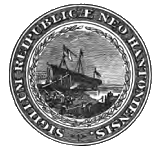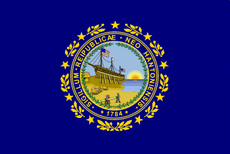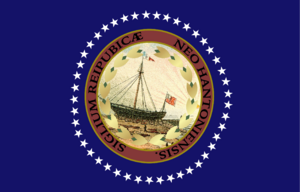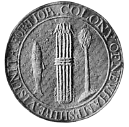Flag and seal of New Hampshire facts for kids
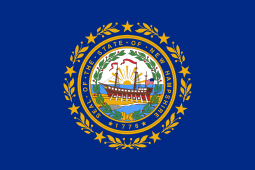 |
|
| Use | Civil and state flag |
|---|---|
| Proportion | 2:3 |
| Adopted | 1909 Modified January 1, 1932 |
| Design | A state seal wrapped by a golden laurel wreath with nine stars on a blue field. |
| Great Seal of the State of New Hampshire | |
|---|---|
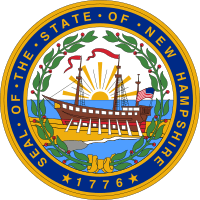 |
|
| Versions | |

Historical coat of arms (1876)
|
|
| Armiger | State of New Hampshire |
The U.S. state of New Hampshire has two important symbols: its official flag and its state seal. These symbols tell stories about the state's past and what it stands for. New Hampshire declared its independence from Great Britain on January 5, 1776. Since then, it has used different versions of its seal. The Great Seal is the one most people know today.
Contents
The Great Seal of New Hampshire
New Hampshire's state seal shows a ship called the frigate USS Raleigh. This ship was one of the first 13 warships built for the new American navy in 1776. It was built in Kittery, Maine, at the Portsmouth Naval Shipyard.
The ship is surrounded by a golden laurel wreath. A laurel wreath is an old symbol of fame, honor, and victory. Inside the wreath, there are nine stars. These stars remind us that New Hampshire was the ninth state to join the United States.
The water in the seal represents the harbor of Portsmouth. The yellow land in the foreground is made of granite. Granite is a very strong rock. It stands for New Hampshire's tough landscape and the strong spirit of its people.
Changes to the Seal Over Time
In 1784, New Hampshire's state constitution was put into effect. The state legislature changed the seal to show a ship being built. It also had a rising sun in the background. This showed that Portsmouth had become a big shipbuilding center during the American Revolutionary War. Over the years, artists sometimes added different items on the dock in the seal.
In 1919, a historian named Otis G. Hammond looked into the history of the state seal. He found that because the law wasn't very clear, artists sometimes added strange details. These included things like rum barrels on the dock!
To fix this, Governor John G. Winant created a committee in 1931. Their job was to design a clear and official seal. The state government approved their ideas. A new law was passed to make the design official. These changes became effective on January 1, 1932.
The 1931 State Seal Law
The 1931 law made the frigate Raleigh the main part of the new seal. The law also said the seal should be 2 inches wide. It would have the words SEAL • OF • THE • STATE • OF • NEW HAMPSHIRE around it. This replaced an old Latin phrase, Sigillum Reipublicae Neo Hantoniensis. The law also stated that only a granite boulder should be shown in the foreground.
The New Hampshire State Flag
The official flag of New Hampshire was adopted in 1909. It has the state seal in the middle of a blue background. Before this, some flags had 45 white stars in a circle around the seal.
New Hampshire's flag is currently the only U.S. state flag that shows a picture of the American Stars and Stripes flag.
Ideas for Flag Changes
In 2018, a former state representative named Timothy Josephson suggested a change. He wanted to replace the seal with the Old Man of the Mountain. This famous rock formation collapsed in 2003, and he wanted to remember it. However, no official changes were made.
In November 2023, another state representative, Tim McGough, proposed adding the state motto, "Live Free or Die," below the seal. This idea was rejected in February 2024.
New Hampshire's Earlier Seals
The First Independent Seal
On July 1, 1774, the First Provincial Congress met in Exeter. They decided to get rid of all "Royal" symbols, including the old "George the III" seal.
For the 1776 state constitution, they designed a new seal. It was 1½ inches wide. It showed an upright fish and a pine tree. These were on either side of a bundle of five arrows. The fish and pine tree represented the main goods traded by the colony. The five arrows stood for the five counties of New Hampshire.
The seal had a Latin phrase: COLONY OF NEW HAMPSHIRE * VIS UNITA FORTIOR. The Latin motto vis unita fortior means "A united force is stronger." This motto was meant to bring the counties together. It was used during the American Revolution until 1784.
The first time this seal was officially recorded was on September 1, 1775. It was used on documents given to military officers. The last known use was on July 5, 1776. This old seal is still sometimes shown today alongside the modern seal.
The First State Seal, 1776
It is thought that the tool used to make the first state seal was designed in the summer of 1776. This first state seal was officially described in a law passed on September 12, 1776. This was just two days after New Hampshire became a state. Some members of the state government still use this seal today.
This seal was a bit larger, 1¾ inches wide. It also had a pine tree and an upright fish. These were on each side of a bundle of five arrows. The design showed the state's two main ways of making money back then. The arrows again showed the strength of unity among the five counties. This seal had a Latin phrase: SIGILL : REI - PUB : NEOHANTONI : * VIS UNITA FORTIOR*.


